In the field of mobile app development, two significant contenders have captured the attention of developers: Flutter vs Java. These technologies offer distinct pathways for creating exceptional applications that cater to the diverse demands of today’s mobile landscape.
In this comprehensive overview, we will explore the strengths and distinguishing features of Flutter vs Java in a formal manner, ensuring that the content remains easily comprehensible to individuals with varying levels of technical expertise.
Before we immerse ourselves in the comparison, let’s take a moment to comprehend the fundamental characteristics of Flutter and Java.
What is Flutter?
Flutter, a dynamic mobile app development framework, emerges as a prominent creation from the minds at Google. It possesses the unique capability to facilitate the construction of high-performance and visually captivating applications, destined for both Android and iOS platforms, all within the confines of a single codebase. Flutter operates with the Dart programming language, recognized for its ease of learning and application.
At the core of Flutter’s allure lies its proficiency in crafting sleek, swift, and responsive apps through a unified codebase. In simpler terms, developers craft code once and then deploy it seamlessly across multiple platforms, saving both time and effort. Additionally, Flutter endows developers with a treasure trove of widgets, animations, and tools, significantly simplifying the often daunting task of app development.
Key Features of Flutter
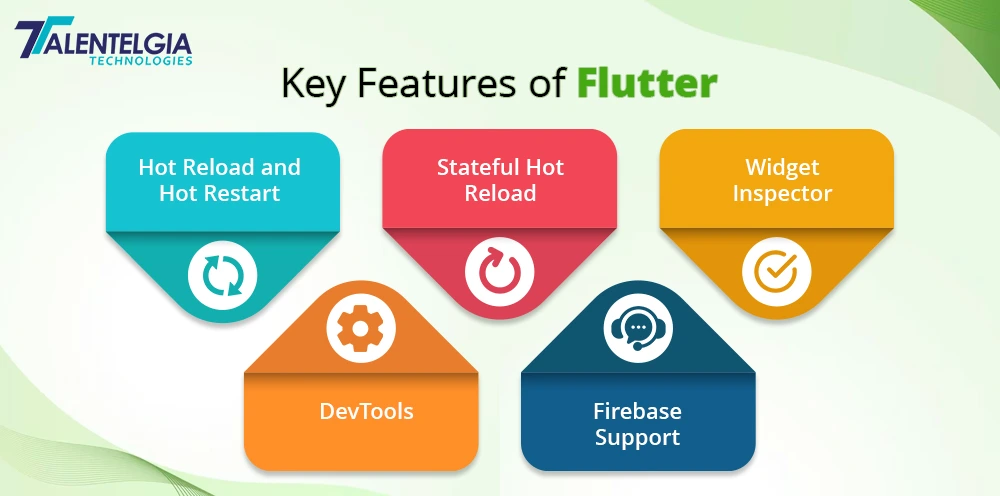
To gain a deeper appreciation of Flutter, let’s explore some of its hallmark features:
- Hot Reload and Hot Restart: These nifty functionalities enable developers to promptly test and debug their code without enduring the hassle of restarting the application or losing the current app state.
- Stateful Hot Reload: Offering an additional layer of convenience, this feature permits developers to introduce alterations to the app’s state during development and witness the immediate repercussions.
- Widget Inspector: A valuable tool within the Flutter arsenal, the Widget Inspector grants developers the ability to scrutinize their app’s widget tree, comprehending the impact of each widget on the app’s layout and visual presentation.
- DevTools: This suite of tools acts as a faithful companion to developers, facilitating the monitoring of app performance, memory usage, network activity, and the identification and resolution of errors.
- Firebase Support: Firebase, a comprehensive platform for app development services encompassing authentication, databases, storage, and analytics, finds seamless integration within Flutter. This feature streamlines the process of incorporating these services into your application.
Benefits of Flutter
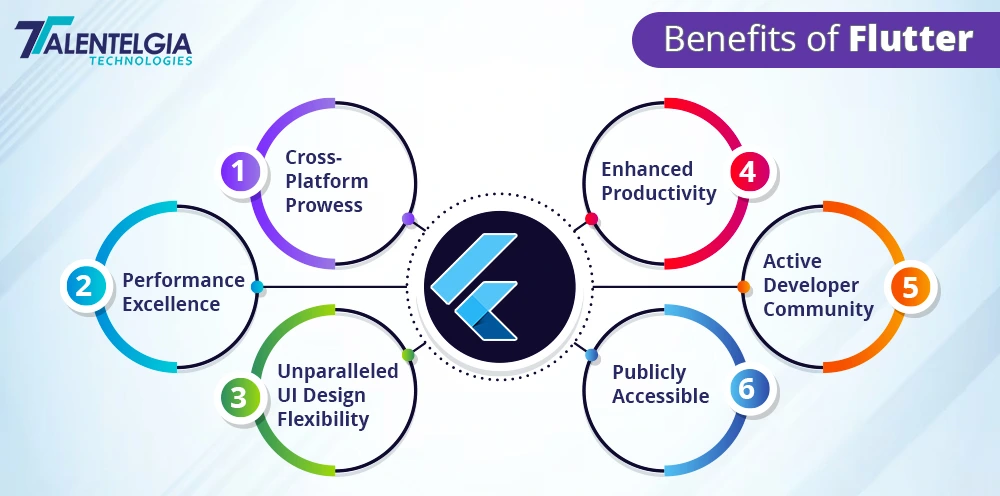
Flutter has numerous advantages that have led to its widespread adoption:
- Cross-Platform Prowess: Flutter is a beacon for cross-platform development, empowering developers to create applications for both Android and iOS while navigating a single codebase. This reduction in platform-specific redundancy translates to substantial savings in terms of time and resources.
- Performance Excellence: Flutter’s underpinning engine operates with remarkable efficiency, rendering user interfaces using native components. This results in a fluid and responsive user experience that’s nothing short of exceptional.
- Unparalleled UI Design Flexibility: The framework provides a flexible and expressive UI framework, empowering developers to create custom widgets and animations that seamlessly blend with the app’s unique theme and style.
- Enhanced Productivity: Boasting an array of features and tools, including hot reload, hot restart, stateful hot reload, widget inspector, and DevTools, Flutter streamlines the development process, fostering heightened productivity and rapid iterations.
- Active Developer Community: Flutter boasts a thriving and engaged community of developers who contribute to its advancement, providing invaluable support and an abundance of resources.
Disadvantages of Flutter
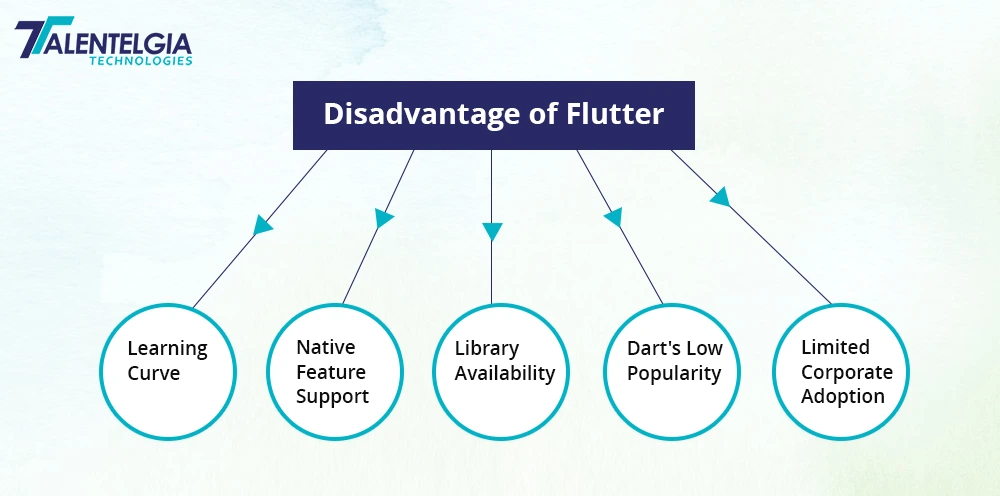
However, Flutter is not without its limitations:
- Learning Curve: The adoption of Flutter may necessitate developers to acquaint themselves with a new programming language (Dart) and a novel framework. This learning curve could potentially impose a time and effort investment.
- Native Feature Support: While Flutter encapsulates a broad spectrum of features, it does not encompass all the native features available on Android and iOS platforms. Certain functionalities like Bluetooth and NFC may require the use of third-party plugins or integration of native code.
- Library Availability: In comparison to Java, Flutter’s library ecosystem, especially for complex or niche functionalities, may appear somewhat limited. Developers might need to embark on the creation of their own libraries or contend with less mature or maintained alternatives.
Java: A Versatile Programming Language
Now, let’s turn our attention to Java, a respected programming language known for its versatility.
Java has been a stronghold in the software development arena since its inception in 1995, surpassing its reputation as the top choice for various application domains including desktop, web, and mobile.
What is Java?
Java, developed by Sun Microsystems in 1995, serves as both a computing platform and a programming language. Its key goal is code reusability, ensuring programs run seamlessly on diverse devices. This versatility is enabled by the Java Virtual Machine (JVM).
Java empowers developers to craft applications compatible with multiple operating systems, promoting cross-platform usability. Originally named “Oak,” it was renamed Java due to trademark constraints.
Basic Features of Java
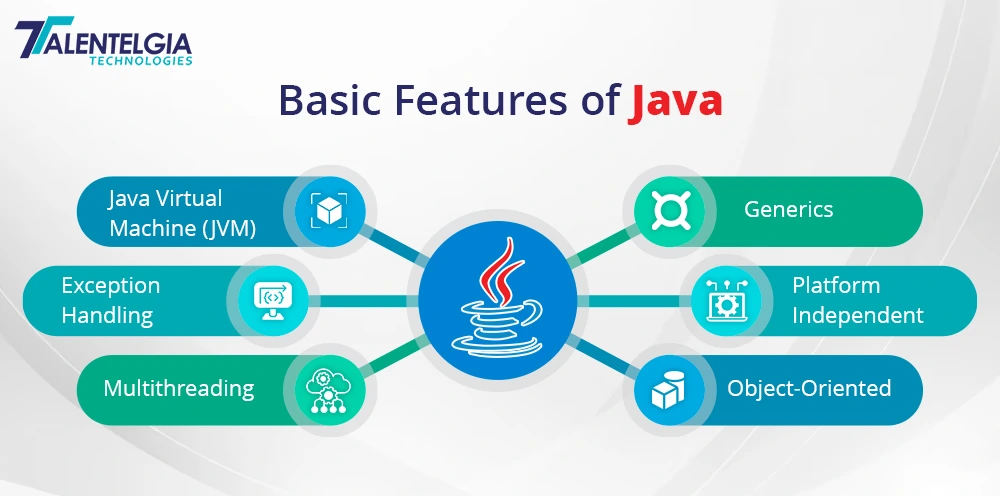
To get a deeper understanding of Java’s capabilities, let’s explore some of its key features.
- Java Virtual Machine (JVM): At the core of Java platform independence is the JVM.
- Object-Oriented Programming (OOP): Java embraces OOP principles, organizing data and behavior into objects that interact seamlessly. This paradigm bolsters code modularity, reusability, and maintainability.
- Exception Handling: Java offers a robust mechanism for managing errors and handling unexpected situations, safeguarding the stability of applications without catastrophic failures.
- Multithreading: Java equips developers with the ability to run multiple tasks concurrently within a single program. This enhances performance and responsiveness, especially in applications demanding multitasking capabilities.
- Generics: Java’s generics feature empowers developers to craft code that can gracefully accommodate varying data types. This reduces code duplication and augments type safety.
Benefits of Java
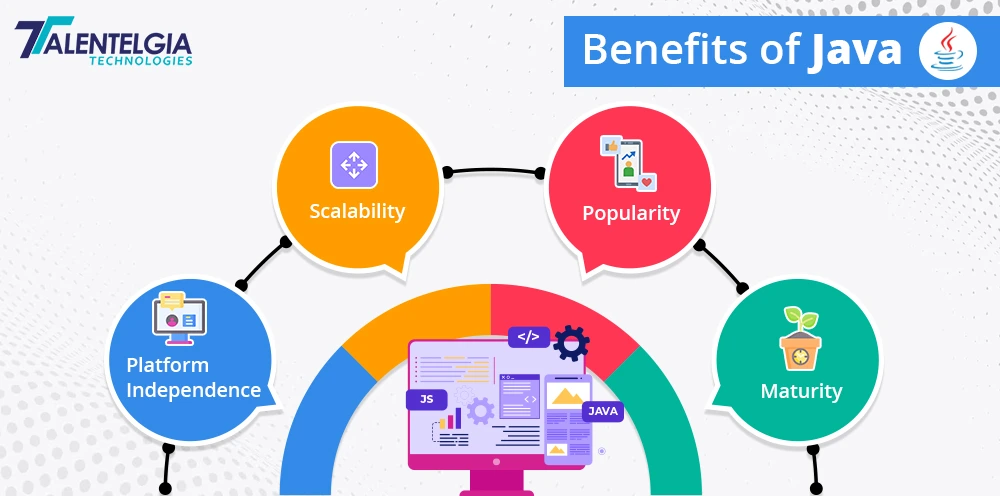
Java’s extensive list of virtues continues to underpin its prominence:
- Platform Independence: Java’s “Write Once, Run Anywhere” capability ensures that code crafted in Java can seamlessly run on any platform that supports the JVM. This encompasses Windows, Linux, macOS, and more.
- Robustness: Java’s suite of features, including robust exception handling, automated garbage collection, and sophisticated memory management, bestow a high degree of reliability upon the language.
- Scalability: Java shines in scenarios necessitating scalability, featuring robust support for multithreading, concurrency management, and distributed computing.
- Popularity: Java stands tall as one of the most widely adopted programming languages worldwide, fostering a substantial community of experienced developers who provide unwavering support and a vast repository of resources.
- Maturity: With over two decades of existence, Java stands as a mature and stable programming language. Its rich library ecosystem spans diverse domains and functionalities, facilitating efficient development.
Disadvantages of Java
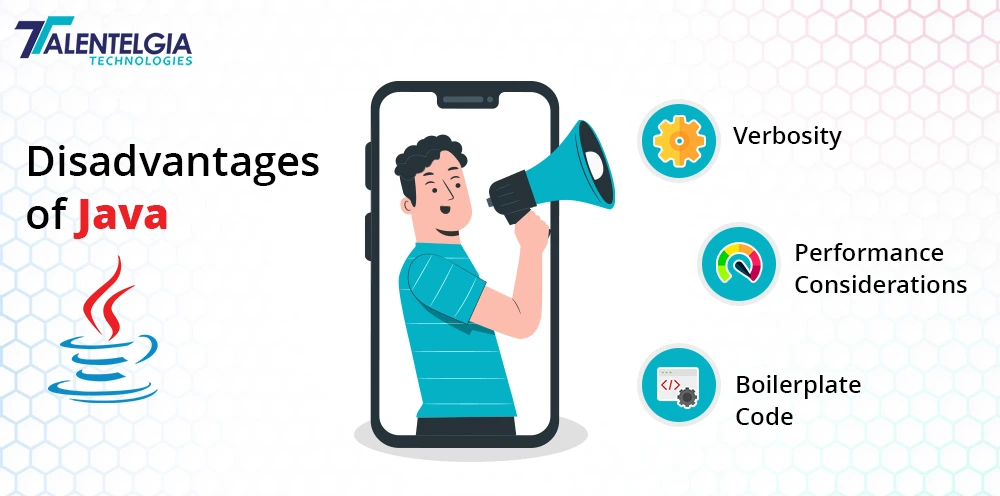
Nonetheless, Java carries its own set of limitations:
- Verbosity: Java is known for its verbosity, often demanding a substantial volume of code to accomplish even relatively straightforward tasks. This verbosity can potentially hamper code readability and maintainability.
- Performance Considerations: Unlike certain programming languages such as C or C++, Java may demonstrate comparatively slower performance, potentially impacting the efficiency of applications, especially those with demanding performance criteria.
- Boilerplate Code: Java involves a notable amount of boilerplate code, necessitating developers to repetitively write code for common tasks such as setters, getters, constructors, and more. This can potentially impede developer productivity and creativity.
Key highlights –
- In simple terms, Flutter is a top pick for developers who want to build apps that work on both Android and iOS. It’s great for cross-platform development.
- Java shines in the creation of intricate Android-only applications, especially those necessitating the utilization of particular native functionalities.
Comparing Flutter vs Java
Now that we have cultivated a comprehensive understanding of Flutter vs Java in isolation, let’s embark on a comparative journey, evaluating these technologies based on several critical criteria.
Flutter vs Java for Android
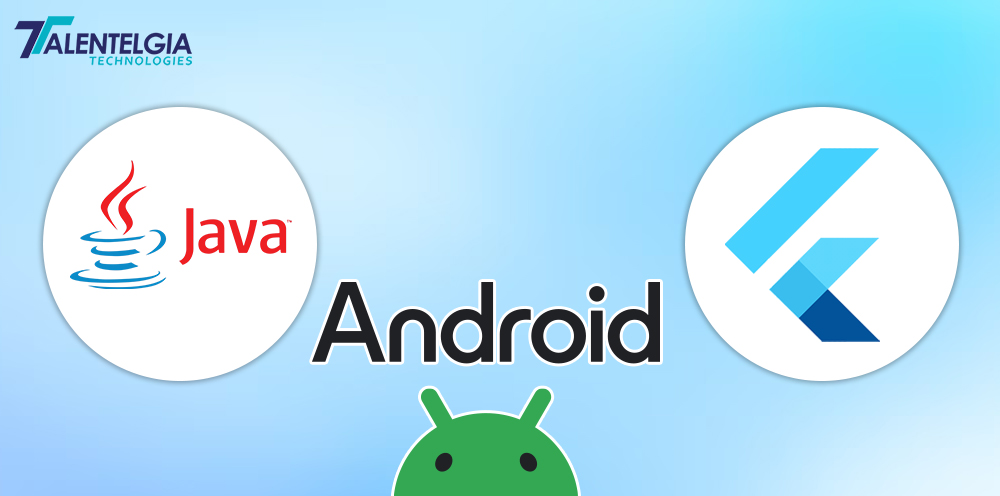
One of the pivotal distinctions between Flutter vs Java lies in their approach to Android app development:
- Flutter: Flutter emerges as a standout choice for apps that seamlessly run on both Android and iOS devices. Flutter’s inherent flexibility lends itself well to standard UI design and circumvents the need for specific native features or libraries.
- Java: Java, on the other hand, is the official language for Android app development. It enjoys unrestricted access to the entire spectrum of native Android features and libraries. If your project is exclusive to the Android platform and necessitates the utilization of particular native functionalities or features, Java might emerge as the preferred option.
Factors to Consider When Choosing Between Flutter vs Java
Several pivotal factors should inform your decision-making process when selecting between Flutter and Java:
- Project Requirements: Carefully evaluate the nature of your app, including its desired features, target platforms, complexity, and unique requirements. These considerations will significantly influence which technology aligns best with your project’s objectives.
- Development Time and Cost: Thoroughly depends on your project’s budget constraints and timeline. Different projects may warrant different technologies based on resource availability and project deadlines.
- Developer Skills and Preferences: Introspect upon your own skills and comfort level as a developer. Your familiarity with Dart or Java can weigh heavily in determining which technology aligns more harmoniously with your abilities and preferences.
Guidelines for Decision-Making
Drawing from these considerations, we can outline some general guidelines to assist you in your choice between Flutter and Java:
- Flutter (Learning Ease): Opt for Flutter if you are new to mobile app development or possess limited experience with programming languages. Flutter’s gentle learning curve, coupled with its wealth of features, makes it an accessible choice for aspiring developers.
- Java (Experience): If you are an experienced mobile app developer, or if you possess a strong command of Java or Kotlin, then Java may be your more favorable option. Java’s maturity, stability, and extensive library ecosystem are well-suited to seasoned developers.
Exploring Use Cases
To round out our understanding of these technologies, let’s explore some of the most prevalent use cases for both Flutter and Java.
Use Cases for Flutter
- E-commerce Apps: Flutter shines as the go-to choice for crafting e-commerce applications that flaunt a seamless and aesthetically pleasing user experience. Such apps often feature a rich array of products and services. Notable examples of e-commerce apps built with Flutter include Alibaba, Groupon, and JD Finance.
- Social Media Apps: Flutter lends itself admirably to the creation of social media applications. These apps require dynamic and interactive UI designs, along with support for a plethora of features like chat, video sharing, and audio communication. Noteworthy social media apps developed using Flutter include TikTok, Reflectly, and Hookle.
- Entertainment Apps: Flutter’s flexibility in UI design makes it a natural fit for entertainment applications that demand captivating and engaging interfaces. These apps offer various forms of entertainment, spanning games, music, movies, and more. Notable examples include Hamilton, Google Stadia, and The New York Times.
Use Cases for Java
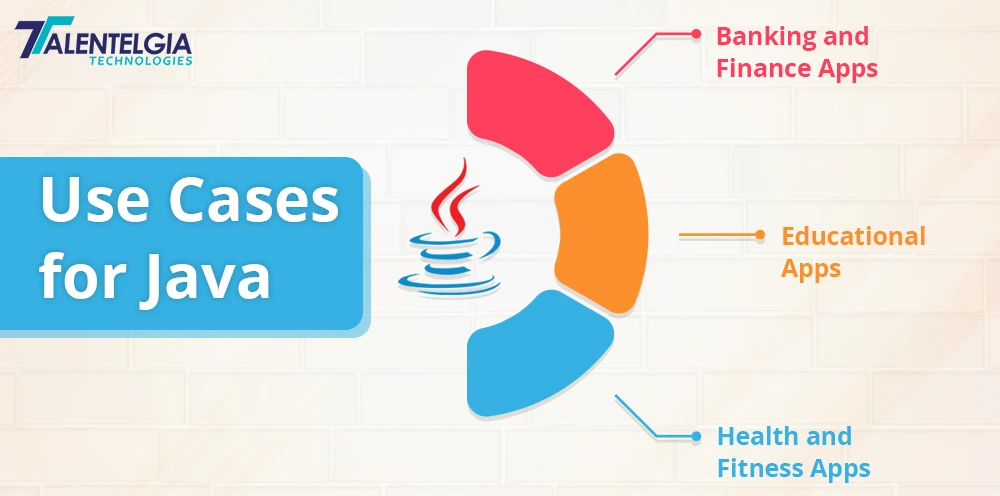
- Banking and Finance Apps: Java’s robustness and security make it the preferred choice for creating banking and finance applications. These apps necessitate a secure and reliable UI design, offering many features such as transaction processing, payment management, investment tracking, and more. Prominent examples in this category include PayPal, Venmo, and Mint.
- Educational Apps: These intelligent platforms offer online courses, quizzes, tests, and more, enhancing user learning experiences. Notable examples include Duolingo, Khan Academy, and Coursera.
- Health and Fitness Apps: Health and fitness apps have their user interface design simple and intuitive, and Java is well suited to fulfill these needs These apps typically offer features such as exercise tracking, health monitoring metrics, providing training, and more for. Notable health and fitness apps developed in Java include Fitbit, Strava, and Headspace.
Frequently Asked Questions (FAQs):
Let’s finish comparing Flutter and Java by tackling some frequently asked questions.
Q: Which is faster – Flutter or Java?
A: The speed used can vary depending on many factors, such as size, complexity, custom design, and so on. In general, Flutter apps often exhibit incredible speeds, due to their reliance on a native engine that uses native components. In contrast, Java apps rely on a virtual machine that interprets the bytecode at runtime.
Q: Which is easier to learn – Flutter or Java?
A: Learning flexibility depends on your personal circumstances and developer preferences. If you are familiar with object-oriented programming languages like C#, C++, or JavaScript, it would seem easy to pick up Dart (implemented in Flutter) because of its modern syntax and vice versa. Java if you already know Java or Kotlin or have Android development experience Can be more accessible due to maturity and extensive documentation.
Q: Which Has More Libraries – Flutter or Java?
A: Java boasts a more extensive library ecosystem compared to Flutter. This disparity arises from Java’s age and broader application spectrum, resulting in a wealth of libraries catering to diverse domains. While Flutter is a newer and more niche framework with fewer libraries, it continues to expand its library repository to encompass the most common functionalities in app development.
Conclusion
In the grand showdown between Flutter vs Java, there is no one-size-fits-all answer. The choice hinges on an intricate interplay of project requirements, development resources, and developer skills and preferences.
For aspiring developers new to the mobile app development landscape or those seeking a gentle learning curve, Flutter beckons with its accessibility and growing community. On the other hand, seasoned developers may find solace in Java’s maturity, stability, and vast library ecosystem.
We trust that this comprehensive exploration of Flutter vs Java has equipped you with the knowledge needed to embark on your next mobile app development endeavor.
Do you have any questions or seek further insights on this topic, please do not hesitate to contact us. Thank you for joining us on this enlightening journey.


 Healthcare App Development Services
Healthcare App Development Services
 Real Estate Web Development Services
Real Estate Web Development Services
 E-Commerce App Development Services
E-Commerce App Development Services E-Commerce Web Development Services
E-Commerce Web Development Services Blockchain E-commerce Development Company
Blockchain E-commerce Development Company
 Fintech App Development Services
Fintech App Development Services Fintech Web Development
Fintech Web Development Blockchain Fintech Development Company
Blockchain Fintech Development Company
 E-Learning App Development Services
E-Learning App Development Services
 Restaurant App Development Company
Restaurant App Development Company
 Mobile Game Development Company
Mobile Game Development Company
 Travel App Development Company
Travel App Development Company
 Automotive Web Design
Automotive Web Design
 AI Traffic Management System
AI Traffic Management System
 AI Inventory Management Software
AI Inventory Management Software
 AI Software Development
AI Software Development  AI Development Company
AI Development Company  AI App Development Services
AI App Development Services  ChatGPT integration services
ChatGPT integration services  AI Integration Services
AI Integration Services  Generative AI Development Services
Generative AI Development Services  Natural Language Processing Company
Natural Language Processing Company Machine Learning Development
Machine Learning Development  Machine learning consulting services
Machine learning consulting services  Blockchain Development
Blockchain Development  Blockchain Software Development
Blockchain Software Development  Smart Contract Development Company
Smart Contract Development Company  NFT Marketplace Development Services
NFT Marketplace Development Services  Asset Tokenization Company
Asset Tokenization Company DeFi Wallet Development Company
DeFi Wallet Development Company Mobile App Development
Mobile App Development  IOS App Development
IOS App Development  Android App Development
Android App Development  Cross-Platform App Development
Cross-Platform App Development  Augmented Reality (AR) App Development
Augmented Reality (AR) App Development  Virtual Reality (VR) App Development
Virtual Reality (VR) App Development  Web App Development
Web App Development  SaaS App Development
SaaS App Development Flutter
Flutter  React Native
React Native  Swift (IOS)
Swift (IOS)  Kotlin (Android)
Kotlin (Android)  Mean Stack Development
Mean Stack Development  AngularJS Development
AngularJS Development  MongoDB Development
MongoDB Development  Nodejs Development
Nodejs Development  Database Development
Database Development Ruby on Rails Development
Ruby on Rails Development Expressjs Development
Expressjs Development  Full Stack Development
Full Stack Development  Web Development Services
Web Development Services  Laravel Development
Laravel Development  LAMP Development
LAMP Development  Custom PHP Development
Custom PHP Development  .Net Development
.Net Development  User Experience Design Services
User Experience Design Services  User Interface Design Services
User Interface Design Services  Automated Testing
Automated Testing  Manual Testing
Manual Testing  Digital Marketing Services
Digital Marketing Services 
 Ride-Sharing And Taxi Services
Ride-Sharing And Taxi Services Food Delivery Services
Food Delivery Services Grocery Delivery Services
Grocery Delivery Services Transportation And Logistics
Transportation And Logistics Car Wash App
Car Wash App Home Services App
Home Services App ERP Development Services
ERP Development Services CMS Development Services
CMS Development Services LMS Development
LMS Development CRM Development
CRM Development DevOps Development Services
DevOps Development Services AI Business Solutions
AI Business Solutions AI Cloud Solutions
AI Cloud Solutions AI Chatbot Development
AI Chatbot Development API Development
API Development Blockchain Product Development
Blockchain Product Development Cryptocurrency Wallet Development
Cryptocurrency Wallet Development About Talentelgia
About Talentelgia  Our Team
Our Team  Our Culture
Our Culture 
 Healthcare App Development Services
Healthcare App Development Services Real Estate Web Development Services
Real Estate Web Development Services E-Commerce App Development Services
E-Commerce App Development Services E-Commerce Web Development Services
E-Commerce Web Development Services Blockchain E-commerce
Development Company
Blockchain E-commerce
Development Company Fintech App Development Services
Fintech App Development Services Finance Web Development
Finance Web Development Blockchain Fintech
Development Company
Blockchain Fintech
Development Company E-Learning App Development Services
E-Learning App Development Services Restaurant App Development Company
Restaurant App Development Company Mobile Game Development Company
Mobile Game Development Company Travel App Development Company
Travel App Development Company Automotive Web Design
Automotive Web Design AI Traffic Management System
AI Traffic Management System AI Inventory Management Software
AI Inventory Management Software AI Software Development
AI Software Development AI Development Company
AI Development Company ChatGPT integration services
ChatGPT integration services AI Integration Services
AI Integration Services Machine Learning Development
Machine Learning Development Machine learning consulting services
Machine learning consulting services Blockchain Development
Blockchain Development Blockchain Software Development
Blockchain Software Development Smart contract development company
Smart contract development company NFT marketplace development services
NFT marketplace development services IOS App Development
IOS App Development Android App Development
Android App Development Cross-Platform App Development
Cross-Platform App Development Augmented Reality (AR) App
Development
Augmented Reality (AR) App
Development Virtual Reality (VR) App Development
Virtual Reality (VR) App Development Web App Development
Web App Development Flutter
Flutter React
Native
React
Native Swift
(IOS)
Swift
(IOS) Kotlin (Android)
Kotlin (Android) MEAN Stack Development
MEAN Stack Development AngularJS Development
AngularJS Development MongoDB Development
MongoDB Development Nodejs Development
Nodejs Development Database development services
Database development services Ruby on Rails Development services
Ruby on Rails Development services Expressjs Development
Expressjs Development Full Stack Development
Full Stack Development Web Development Services
Web Development Services Laravel Development
Laravel Development LAMP
Development
LAMP
Development Custom PHP Development
Custom PHP Development User Experience Design Services
User Experience Design Services User Interface Design Services
User Interface Design Services Automated Testing
Automated Testing Manual
Testing
Manual
Testing About Talentelgia
About Talentelgia Our Team
Our Team Our Culture
Our Culture
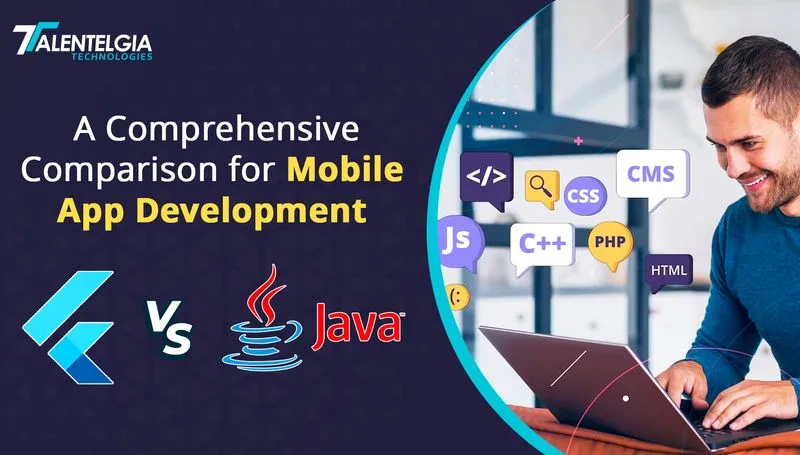



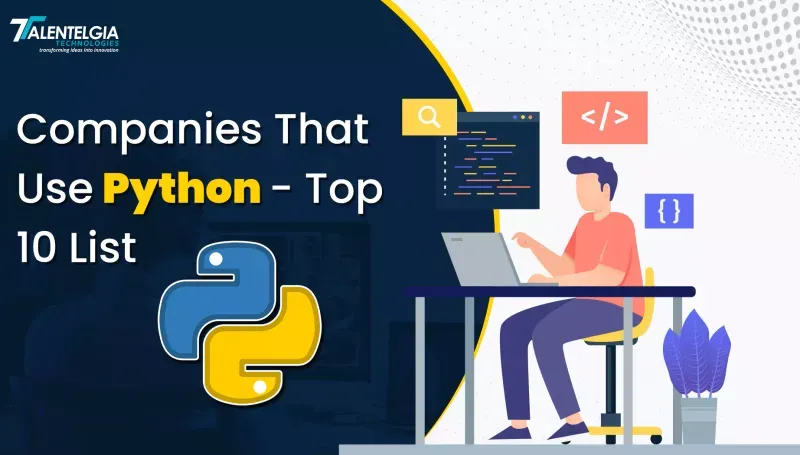
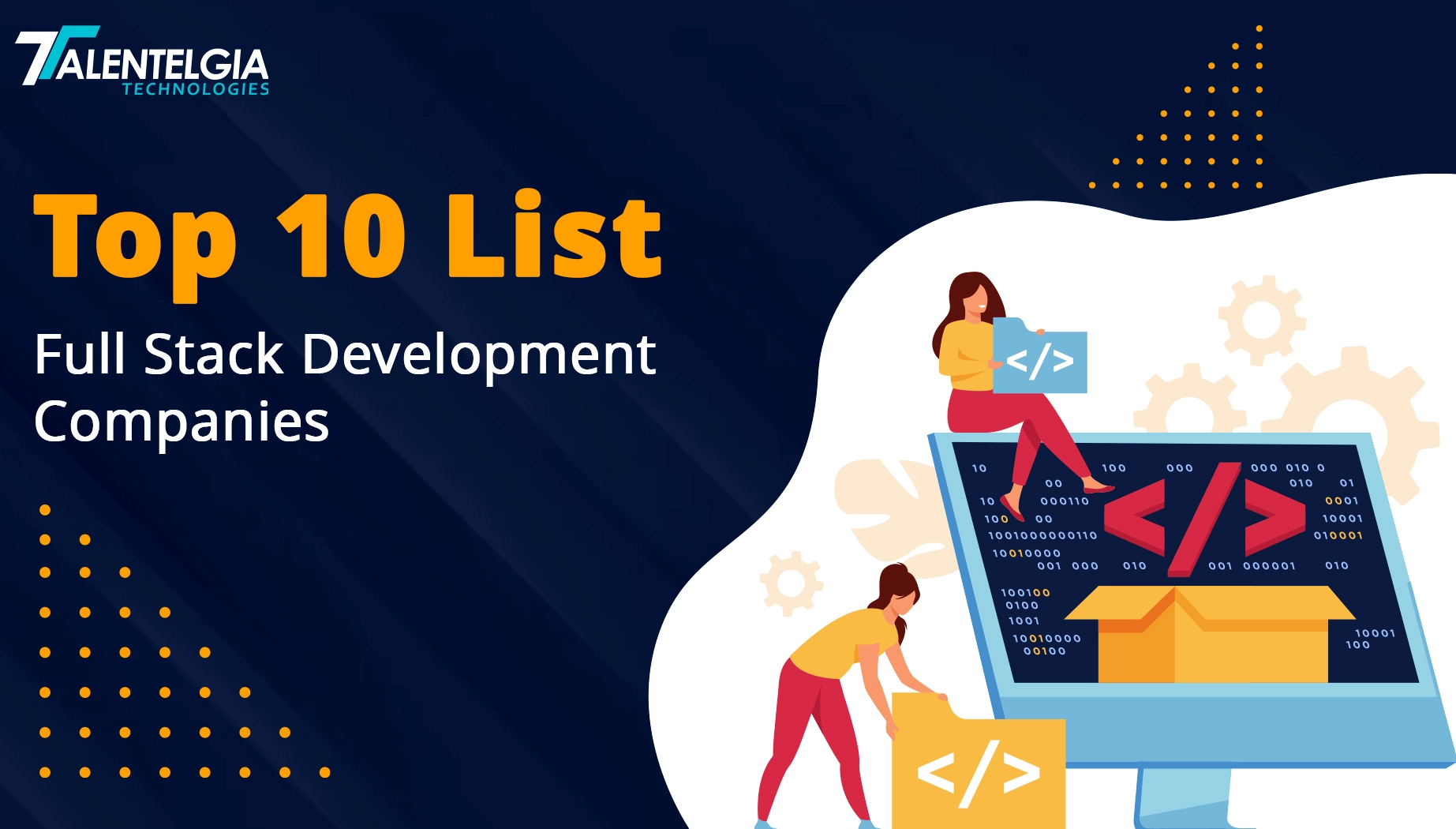











 Write us on:
Write us on:  Business queries:
Business queries:  HR:
HR: 




